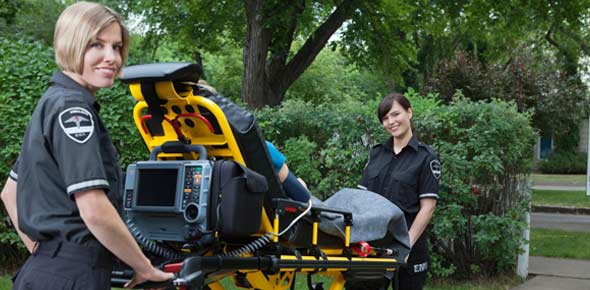EMT-b Cardiovascular Emergencies

Flashcard Q's I have have from my EMT-B book (AAOS Emergency Care and Transpotation of the Sick and Injured) CHAPTER 12 cardiovascular emergencies.
- 1.
If you are traveling to the hospital with an un conscious patient, check the pulse at least every_______.
- A.
5 min
- B.
30 sec
- C.
60 sec
- D.
15 min
- E.
90 sec
Correct Answer
B. 30 sec -
- 2.
(useing an AED)You should begin transport when which of the following occurs:
- A.
6-9 shocks have been delivered
- B.
When patient says "take me now"
- C.
AED gives 3 consecutive "noshock" messages
- D.
A and B
- E.
A and C
Correct Answer
E. A and C -
- 3.
Defibrillation works best if it takes palce within _____ of the onset of cardiac arrest.
Correct Answer
2 min
2 minutes - 4.
The 4 links in the chain of survival are: _____, ______, ______, ______.
Correct Answer
early access, early CPR, early defibrillation, early advanced care - 5.
In the late ____, and the early ____, scientists developed a small computer that could analyze electrical signals from the heart and determine when ventricular fibrillation was taking place.
Correct Answer
1970, 1980
1970 and 1980
70s and 80s
70's 80's - 6.
What does AICD stand for?
Correct Answer
automatic implantable cardiac defibrillator - 7.
What does PTCA stand for?
Correct Answer
percuntaneous transluminal coronary angioplasty - 8.
What does CABG stand for?
Correct Answer
coronary artery bypass graft - 9.
When the pressure in the capillaries exceeds a certain level, fluid(mostly water) passes through the walls of the capillary vessels and into the alveoli. This condtion is called what?
Correct Answer
pulmonary edema - 10.
______ can occur anytime after a myocardial infarction, heart valve damage, or long standing high BP, but usually happens between 1st few hours and 1st few days after a heart attack.
Correct Answer
CHF
congestive heart failure - 11.
All of the following are treatment of a patient with cardiogenic shock EXCEPT:
- A.
Postion comfortably
- B.
High-flow oxygen
- C.
Vetilations as necessary
- D.
Bring temp down
- E.
Transport promptly
Correct Answer
D. Bring temp down -
- 12.
Cardiogenic shock can occur immediatly or as late as ______ after the onset of AMI.
Correct Answer
24 hours - 13.
___________ is present when body tissues do not get enough oxygen, causing body organs to malfunction.
Correct Answer
shock - 14.
What does VT stand for?
Correct Answer
ventricular tachycardia - 15.
What does VF stand for?
Correct Answer
ventrucular fibrillation - 16.
Most cases of VT will be substained and may deteriorate into:
Correct Answer
VF
ventricular fibrillation - 17.
Even if CPR has begun right at the time of collapse, chances of survival diminish ______% each min until defibrillation is accomplished.
Correct Answer
10
10% - 18.
If uncorrected, unstable VT or VF will eventuallly lead to _________.
Correct Answer
asystole - 19.
About ______% of all patients with AMI never reach the hospital.
- A.
25%
- B.
40%
- C.
50%
- D.
35%
- E.
10%
Correct Answer
B. 40% -
- 20.
In many cases, opening the coronary artery can prevent damage to the heart muscle if done within ________ after onset of symtoms.
- A.
First 30 min
- B.
First 90 min
- C.
First 1 1/2 hours
- D.
First day
- E.
First hour
Correct Answer
E. First hour -
- 21.
After about _______ of blood flow cut off, as many as 1/2 of the cells in the heart muscle can be dead.
- A.
1 hour
- B.
2 hours
- C.
30 min
- D.
20 min
- E.
4 hours
Correct Answer
B. 2 hours -
- 22.
In most cases, after _________ of blood flow cut off, more than 90% of cells in the heart muscle will be dead.
- A.
1-2 hours
- B.
2-3 hours
- C.
3-5 hours
- D.
4-6 hours
- E.
5-7 hours
Correct Answer
D. 4-6 hours -
- 23.
About ______ after blood flow is cut off, some heart muscle calls begin to die.
- A.
30 min
- B.
25 min
- C.
20 min
- D.
15 min
- E.
10 min
Correct Answer
A. 30 min -
- 24.
Angina Pectoris may be associated with which ONE of the following:
- A.
Nausea
- B.
Temp
- C.
Pinkish urine
- D.
Dark skin
- E.
Hyperavtivity
Correct Answer
A. Nausea -
- 25.
Angina pain usually lasts ___ to ___ min, rarely longer than ___ min.
- A.
3 to 6 min / 20 min
- B.
3 to 8 min / 7 min
- C.
3 to 8 min / 15 min
- D.
3 to 7 min / 10 min
- E.
3 to 6 min / 6 min
Correct Answer
C. 3 to 8 min / 15 min -
- 26.
The major controllable factors for myocardial infarction are all of the following EXCEPT:
- A.
Smoking
- B.
High BP
- C.
Diabetes
- D.
Lack of exercise
- E.
Low stress
Correct Answer
E. Low stress -
Quiz Review Timeline +
Our quizzes are rigorously reviewed, monitored and continuously updated by our expert board to maintain accuracy, relevance, and timeliness.
-
Current Version
-
Jan 11, 2013Quiz Edited by
ProProfs Editorial Team -
Apr 15, 2010Quiz Created by
KCfutureflymed
 Back to top
Back to top


